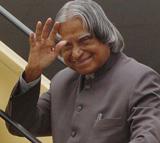
New Delhi, June 14: The ruling United Progressive Alliance (UPA) on Thursday appeared headed for an internal confrontation over the next month’s presidential election as Trinamool Congress chief Mamata Banerjee declared that former president A P J Abdul Kalam would be her candidate for the top post.
Mamata announced that she will field Kalam if the Congress went ahead with the nomination of either Union Finance Minister Pranab Mukherjee or Vice-President Hamid Ansari.
The stage for the confrontation was set early during the day when the Congress rejected the possibility of nominating Prime Minister Manmohan Singh, or accepting Kalam or former Lok Sabha speaker Somnath Chatterjee as the UPA candidate. The three names were jointly proposed by Mamata and Samajwadi Party leader Mulayam Singh Yadav on Wednesday.
Congress general secretary in-charge of media affairs Janardhan Dwivedi came out publicly rejecting the three names, and objected to the Trinamool Congress’s announcement on Wednesday that Mukherjee and Ansari were the Congress’ first and second choice candidates respectively.
The Congress leadership held a series of meetings during the day to deliberate on the party’s nominee, with party chief Sonia Gandhi separately confabulating senior leaders like Mukherjee, Union Home Minister P Chidambaram and Defence Minister A K Antony separately and then together in the party’s core group.
The party leadership also held consultations with other UPA allies like the NCP chief Sharad Pawar and senior DMK leader T R Baalu. Both of them pledged support to the candidate the Congress would choose. The UPA leaders were expected to meet on Friday morning, to decide on a nominee.
While the Congress leadership rejected the three names proposed by Mamata, it scrupulously avoided naming either Pranab or Ansari as likely candidates. Indeed, the party clarified that Sonia had not mentioned to the Trimanool Congress leader during their meeting on Wednesday that Pranab and Ansari were its probable candidates in that order.
All that Sonia had told Mamata was that these two names had figured during the party’s consultations with its UPA allies.
Curiously, in the midst of all these, CPI leader A B Bhardhan, who was among the first to favour a woman candidate for the 2007 presidential election, proposed during the day that the next president should be a dalit woman. He did not take any names, but speculations were that he could be having Lok Sabha Speaker Meira Kumar in mind.
And, with Mamata on a confrontation course, the Congress seemed intent on reaching out to the Left parties for support in the election. Mukherjee reportedly spoke over phone to former West Bengal Chief Minister Buddhadeb Bhattacharjee, who in 2008 was against the CPM leadership’s decision to withdraw support to the UPA-I government.
However, the CPM leadership in the national capital maintained silence, though it criticised the UPA’s handling of the presidential nomination.
But, Mamata was categorical about her choice. She asserted that she will contest the UPA choice with Kalam as her candidate, particularly if the Congress choice were to be either Mukherjee or Ansari. She met Mulayam late in the evening after throwing up a challenge to the Congress.
While Mulayam, who had earlier favoured a seasoned politician for the post of President, maintained silence, Mamata declared: “Kalam is our and Mulayam Singh Yadav's number one candidate. He will be the best candidate."
She will not be attending the Friday’s scheduled UPA meeting. But said she was not walking out of the UPA either. “As far as the Trinamool is concerned, we are in the UPA. We don’t want to topple the government. But if the Congress does not want us, it is left to them. The ball is in the Congress’ court.”
Mamata’s latest stand may be music to the ears of the opposition NDA and other parties like the Biju Janata Dal and the AIADMK. They may be willing to endorse Kalam.




Comments
Add new comment